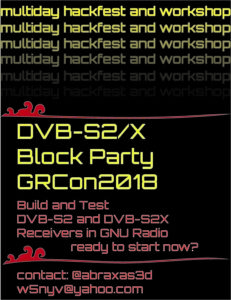The European Space Agency has a Call for Proposals concerning Geostationary Amateur Payloads. We have contributed a technical support package and communicated our standalone HEO/GEO design to the ESA.
Thank you to all the volunteers that have contributed towards this achievement.
QoS: Call for Input
We’re moving into the challenge of multiplexing on the transponder with a goal of delivering Quality of Service (QoS) metrics and policies.
This is “how do the uplink packets get properly prioritized on the downlink, to make the most of limited resources”.
These resources are spectrum, power, and time.
QoS doesn’t make any of our communications channels go faster. This is a common misconception about QoS. Here’s some descriptions from conversations this week. I would like to hear more opinions about QoS in general, and any specific requirements that people on this list might have.
Kenneth Finnegan writes,
“In #networking it’s common to forget that QoS is mainly about deciding which packets you’d rather drop first.
If you don’t like that idea, then you just need to pony up and throw more capacity at the problem.”
Adam Thompson continues,
“In the presence of a pizza that’s not big enough for all the hungry people, QoS inhibits less-important pizza eaters. This lets more-important eaters-of-pizza get more pizza than their fair share, at the expense of the less-important eaters.
“In the presence of a pizza that’s not big enough for all the hungry people, QoS inhibits less-important pizza eaters. This lets more-important eaters-of-pizza get more pizza than their fair share, at the expense of the less-important eaters.
QoS never (ever!) makes the pizza bigger – if you need more pizza, you must still bake or buy more, or someone’s going to go hungry!
Complex QoS systems might let you differentiate between e.g. crust and topping and permit cutting the pizza into bizarre topographies/topologies, but still can’t make the pizza any bigger.
Finally, if there is enough pizza for everyone, QoS doesn’t do anything useful.”
If this last part sounds familiar, then you’re not alone. QoS often doesn’t do anything useful… in a resource rich environment. This may be the main reason that we sometimes hear that QoS is a “failure”, that it’s “never used”, or “why bother for hams since hams don’t care about this subject at all”.
It is true that most amateur communications are made with acres and acres of spectrum, with a very generous power limit (although you are supposed to use the minimum required power) and no time limits on how often you can try to make a contact.
When we talk about microwave broadband digital communications, it’s a different situation. And, with space channels, there are constraints. We have less bandwidth to work with because we’re on a sub-band. We have latency, which is non-trivial for GEO or beyond. We have power concerns and pointing requirements.
“Adaptive” QoS that does nothing until congestion forces some decisions, at which time we sort with respect to SNR, has been our baseline.
What we want to do when constraints are hit is what we need to better define. Right now, we have a whiteboard design (summarized above) and a paper about Adaptive Coding and Modulation (ACM) that was published in AMSAT-DL and AMSAT-UK Journals.
We have the implementation guidelines from GSE as well, which address QoS and show how to set up queues.
With a controllable downlink going out over the air, and a defined uplink protocol, now is the time to work on exactly how to multiplex the traffic. Evariste asked about this exact thing less than a week ago at the FPGA meetup.
Decisions about QOS heavily affect the central part of the design, so let’s get this right.
Do you have experience implementing QoS policies? Do you have experience with bad QoS policies as a consumer? Do you have an idea about what you want to see this design do?
Well, you’re in the right place, and we’d love to hear what you have to say about it.
Participate at https://openresearch.institute/getting-started
September 2022 QSO Today Ham Expo – ORI’s Open Source Technical Presentations
These are our technical talks from the September 2022 QSO Today Ham Expo.
Thank you to everyone that supports our work ❤️
How Can Open Research Institute Help *You*?
Thank you so much for visiting with us at QSO Today Ham Expo! We hope you found it as enjoyable, vibrant, and inspiring as we did.
We presented five talks, had three project exhibits, and a booth. You can find a summary below.
Your interest in our work is appreciated. We want you to enjoy open source non-profit digital radio and amateur radio to the fullest. How can we help?
Here is how to get involved with what we do:
https://www.openresearch.institute/getting-started/
Here’s a roundup of what we brought to Ham Expo. All of what we do is published as it is created. Our work is free to the general public at no cost.
-=-=-=-=-=-=-=-=-=-
Ribbit, a new digital text messaging mode for UHF/VHF emergency communications
Presentors: Pierre Deliou W4CKX, Ahmet Inan
Level: General Audience Category: Emergency Communications Time:
PDT: September 18, 2022, 10:00 am UTC: September 18, 2022, 5:00 pm
Ribbit is a novel digital text messaging mode for VHF/UHF communications for recreational and emergency use which radically increases the density of information transmitted by spectrum used. It leverages the computing power of the modern smartphone to increase the capabilities of any Handy Talkie without requiring any additional hardware. Its redundant distributed nature allows it to function even when connectivity to the internet is lost during emergencies. Ribbit is open source and currently in its early stages of development. Get the free Android app here: https://play.google.com/store/apps/details?id=com.aicodix.rattlegram
Artificial Intelligence and Machine Learning and the Future of Amateur Radio
Level: Intermediate Category: DSP and Software Design, Future of Amateur Radio, SDR Software Defined Radio, Software and Services Time:
PDT: September 17, 2022, 1:00 pm UTC: September 17, 2022, 8:00 pm
Artificial Intelligence and Machine Learning are all over the news, taking over academia, getting billions of dollars of commercial investment, and will change both computer networking and wireless communications in fundamental ways. What does the future of amateur radio look like when radios use machine learning to operate? How does our relationship to the bands change with cognitive radio? Where are we in this transformation? What will happen next?A working group to produce an AI/ML Handbook for Amateur Radio is forming now. Register your interest here: https://forms.gle/4dZsLkmyxCkp8JiF6
Truly Excellent Digital Voice Quality: Opulent Voice
Presentors: Paul Williamson KB5MU
Level: General Audience Category: Digital Voice Mode, DSP and Software Design, Software and Satellites, Space and Satellites Time:
PDT: September 17, 2022, 9:00 am UTC: September 17, 2022, 4:00 pm
Digital voice on amateur radio to date has generally had terrible voice quality, due to both a perception of limited available bandwidth and the convenience (to manufacturers) of repurposing commercial protocols with their older, proprietary, low-bitrate voice codecs. We present and demonstrate a modern digital voice design that can be used on 222 MHz and above with truly excellent voice quality. Source code here: https://github.com/phase4ground/opv-cxx-demod
Haifuraiya – Open Source HEO Satellite Project Proposal
Presentors: Michelle Thompson W5NYV
Level: General Audience Category: Space and Satellites Time:
PDT: September 18, 2022, 9:00 am UTC: September 18, 2022, 4:00 pm
Haifuraiya is an open source highly elliptical orbit amateur satellite project proposal. This presentation will walk through the high-level project proposal. The project features a digital microwave multiplexing transceiver with a failover transponder mode, has an international volunteer team open to community participants, and complies with debris mitigation guidance from the United States Federal Communications Commission. Repository here: https://github.com/phase4ground/documents/blob/master/Papers_Articles_Presentations/Slide_Presentations/haifuraiya/README.md
User Authentication for Amateur Satellites
Presentors: Paul Williamson KB5MU
Level: General Audience Category: DSP and Software Design, Software and Satellites, Space and Satellites Time:
PDT: September 17, 2022, 8:00 am UTC: September 17, 2022, 3:00 pm
After a brief discussion of the reasons why user authentication is needed on an amateur satellite service system, we’ll cover a proposed system to implement reasonably secure user authentication on a P4XT digital multiplexing satellite transponder, within the bounds of the (United States) rules.
We had three project showcases in the Project Gallery
Each Gallery had a Q&A tab, a poster or document, links to any papers, and a link to any associated video presentations.
1) Ribbit, a distributed digital messaging platform
2) Opulent Voice – High Bitrate Digital Voice and Data
3) Open Source Satellite Work is Free of ITAR/EAR
Kumospace Lounge
Thank you to Ham Expo for providing fun and effective Lounges for interaction at the conference. We truly enjoyed visiting with everyone that dropped by! We hope you enjoyed our themed events and the extended Q&A in the Lounges.
-=-=-=-=-=-=-=-=-=-
ORI participation at OSCW 2021
Recording, transcript, and slides of Open Research Institute’s presentation at Open Source Cubesat Workshop 2021.
Hello everybody! I’m Michelle Thompson W5NYV and I’m here to tell you all about what Open Research Institute is and what we have been doing.
Open Research Institute (ORI) is a non-profit research and development organization which provides all of its work to the general public under the principles of Open Source and Open Access to Research. As we all know, these mean particular things, and those things have to be defined and they have to be defended.
Open Source is type of intellectual property management where everything you need to recreate or modify a design is freely available. As a baseline, we use GPL v3.0 for software and the CERN Open Hardware License version 2.0 for hardware. All we do is open source work, primarily for amateur radio space and terrestrial, but also some other fields, as you will see.
So who are we?
Here is our current board, and our immediate past CEO Bruce Perens. We have one opening on the board, as Ben Hilburn, one of our founders, very recently retired from being an active Director at ORI. He remains as one of our senior advisors. We are looking for someone to join ORI board that supports what we do and wants to help make it happen. It’s an active role in a flat management structure. Board members are are experienced in management, engineering, operations, and technology, and three out of the current number of four are from underrepresented groups in STEM.
As a board, it is our mission to serve our participants, developers, and community members. We now have at least 535 that participate in what we call the Open Source Triad: our mailing list, Slack, and GitHub. All work is organized in independent projects or initiatives.
We have some affiliations and we proudly ascribe to the Open Space Manifesto from Libre Space Foundation. We work with radio organizations, several universities, and have worked with a variety of for-profits.
What do we do?
Here’s a visual summary of top level projects and initiatives. The vertical axis is risk. Higher risk projects are at the top, lower risk projects are at the bottom. Maturity increases left to right. Maturity may indicate schedule, but the score is also influenced by complexity or difficulty. The color of the shape indicates how much stress that project is under or what the risk level is at this time. The size of the shape is the budget estimate. By far, the largest budget, riskiest, and least mature work is in the AquaPhage project, which is open source bacteriophage research and development. Bacteriophage are viruses that attack and destroy bacteria. This is biomedical and not amateur radio. This project was halted by COVID and has not yet resumed.
Our digital multiplexing payload project is called P4DX, and it’s in the middle in green. This is a multiple access microwave digital regenerating repeater for space and terrestrial deployment.
Channels divided in frequency are the uplink. The uplink is on 5 GHz. The processor on the payload digitizes and multiplexes these signals and uses DVB-S2/X as a single time-division downlink. The downlink is on 10 GHz. The system adapts to channel conditions and handles things like quality of service decisions. For example, low and high latency digital content. The uplink is divided up using a polyphase channelizer, based on the open source work done by Theseus Cores.
For the current prototype, we are only using MPEG transport stream, but generic data is the goal. The prototype beacon signal is 5 MHz wide and we are using one modulation and one error coding (yet). We are not yet rotating through all the allowed combinations in DVB-S2 (yet).
Our prototype work can also serve as a terrestrial multimedia beacon. Work was demonstrated to groups with mountaintop spaces in October 2021, and deployment will be as soon as possible.
M17 project is an open source VHF/UHF radio protocol. Think open source digital mode HTs and repeaters. This project is only slightly more stressed than P4DX, but it’s further along in maturity because it’s narrower in scope. We believe M17 Project will be very successful from current development to scaling up to commercial product launch. The M17 protocol is the native digital uplink protocol, with some modifications for 5GHz, for P4DX. We are working hard to get M17 on and through more satellites and more sounding rocket tests today.
Engineers General is our initiative to hire highly competent open source workers to reduce burnout and increase quality in open source work important to amateur radio. We have one contractor currently, eight resumes, and have applied for funding for two more. We are actively looking for funding for the remaining five.
The “birdbath” is a large dish antenna at the Huntsville Space and Rocket Center. This was used in the past, but has been parked for decades. It took two years of negotiation, but ORI has the support of the museum and permission to begin work renovating this dish for citizen science and amateur radio educational use. Work parties from earlier this year were rescheduled due to COVID.
Upper right there are two completed projects. One is ITAR/EAR Regulatory Work. It took over a year, but we received a determination from the State Department that open source satellite work is free of ITAR, from Commerce that it is free of EAR, and we obtained an advisory opinion that publishing on the internet counts as publishing under the regulations. This is a huge step forward for not just amateur radio, but anyone that wants to contribute to open source space work.
Debris Mitigation Regulatory Work took 10 months to complete. The process culminated in a highly successful meeting with the FCC Wireless Telecommunications Board, the Office of Engineering Technology, and the Satellite Bureau in late October 2021.
Lower right is Battery Matching, a project that matches NiCd cells for very durable batteries in the style that used to be done in amateur satellites, and puts the methods and documentation in the public domain.
AmbaSat Inspired Sensors used to be on the bottom right but now it’s bumped back a bit in maturity level is higher risk. This was supposed to be a project done by students at Vanderbilt university, but no students materialized, primarily due to COVID. We had one kick-butt professional volunteer who was working on a 10GHz beacon that went into the sensor connector on the main board, but the project was moving slowly, and ORI decided to provide additional operational support. Additional volunteers joined the team, we reviewed the finances, and then took some actions. We updated the main board to move it from the illegal ISM band it was in to the legal 70cm ham band. We improved power and ground and addressed some other design concerns. The boards are back as of last week and software and firmware development is underway. The 10 GHz sensor “beacon” work is proceeding quickly as well. AmbaSat is an excellent educational platform, but the ISM band decision isn’t the only problem with it. It’s very small.
We decided to look at combining the 70cm AmbaSat with another open source satellite board to make a combined spacecraft design. I reached out to Pierros Pappadeus at Libre Space, and we are moving forward with using the SatNOGS Comms project. We look forward to contributing to the FPGA codebase and flying both AmbaSat and SatNOGS Comms designs as early and as often as possible, starting with sounding rockets and ending up in space.
All of these projects are open source and all work is published as it is created.
When?
We have timelines! We were incorporated in February of 2018, got our 501c3 in March of 2019, and we hit the ground running and haven’t stopped since.
We’ll distribute a copy of the slides so you can see our wins and losses along the along the way. There’s a lot going on in here.
Here’s what’s been going on since March, and the future plans we know about.
We use Agile framework for management, and most of us have some sort of formal certification either completed, or in process. This is the Agile manifesto and it is the foundation of how our board decides things and how it supports project leads and volunteers. Note the second item, and put in the word hardware instead of software, and that’s one of the reasons we demonstrate early and often and incorporate the feedback quickly.
Where are we?
Here’s the locations of the concentrations of current major contributors and participants. When we say international, we mean it. Our participants have a wide range of ages, are generally educated in engineering, come from a variety of backgrounds, but do tend to be relatively young and male.
We have some physical locations that are important for carrying out the work we do. Remote Labs are lab benches connected to the internet that allow direct access to advanced lab equipment and two different large Xilinx development boards and DVB-S2/X gear. We have relocated our second Remote Lab equipment from Florida to Arkansas, and have added a three-dish interferometry site for amateur radio and public science use. Remote Labs are here for you all to use. If you need large FPGA resources and test equipment up to 6 GHz, then we have your back.
We bought Open Lunar Foundation’s satellite lab. It’s in storage waiting for the M17 project lab construction to conclude, and then the equipment will go there to pack that lab full of wonderful test equipment, materials, and supplies.
Why do this?
We believe that an open source approach to things like amateur digital communications, bacteriophage research, and sticking up for the non-commercial use of space will result in the best possible outcomes for the good of humanity.
We have a lightweight agile approach to doing things. We keep our overhead very low, we are radically participant-focused, and the work must be internationally accessible.
You can see that public demonstrations and regulatory work are given a high priority. Working code and working hardware are highly valued. Working means working over the air.
Thank you to everyone at Libre Space for the support and opportunity to present here today.
https://www.openresearch.institute/wp-content/uploads/2021/12/OSCW-2021-W5NYV-ORI-1.pdf
Remote Labs Equipment Review
Transcript of Introductory Remarks
Greetings all,
Welcome to the Open Research Institute Remote Labs Equipment Review.
Open Research Institute (ORI) is a non-profit research and development organization which provides all of its work to the general public under the principles of Open Source and Open Access to Research.
Remote Labs are two physical lab benches. They have equipment for advanced digital communications design work. This equipment will be accessible online to anyone, anywhere that wants to work on open source amateur radio satellite service or open source amateur radio terrestrial engineering development.
The primary focus of the equipment list reviewed today is to support the design, verification, and test of the DVB family of links. DVB-S2, S2X, and T2 are all commonly found in amateur radio. DVB-S2X is the protocol family used by Phase 4 Ground and Space.
Remote Labs is a part of an extremely important process of re-establishing free and open international collaboration with groups such as AMSAT-DL, JAMSAT, and AMSAT-UK, and to increase and amplify collaboration with Libre Space and other open source groups. This is possible for ORI to do by using the open source carve-outs in the US export control regulatory framework. These controls have impeded international cooperation on amateur satellite work for a long time.
A significant amount of regulatory relief was achieved over the summer by ORI for amateur radio satellite work, and more work is going on right now to build upon this success. Please see the Open Research Website news section for more details on that. Today’s discussion is not about satellite technology, but about the equipment and resources required.
We are fortunate to have the advice and input of people that make a living by using remote labs at work. The advice received so far has been heard and acted upon. Python, HTML5 plus Javascript, and command line access will be the initial methods upon to provide secure access to the equipment.
We will not be writing or using a heavy or complex software framework for the Remote Lab. We will be authorizing and authenticating users. It is highly likely that we will use the same authentication and authorization approach that we intend to use for payload communications access, in order to get more experience with that design. In other words, you may be authenticated and authorized for Remote Labs the same way that you will be authenticated and authorized for the payload communications system.
We will definitely be documenting how to use the lab. We will be responsive to feedback about accessibility and ease of use.
There will be someone physically present at the Remote Labs. The equipment is not installed in racks at an unattended site. If a function needs on-site setup, or a test plan can only be done with someone physically at the bench, then that’s how the work will be done.
Remote Labs is offered as a community resource. Therefore, the review process must include community feedback. Thank you for your time here today to discuss and review the equipment list.
As an example, Thomas Parry has provided the following feedback.
1) The initial list had no power supply listed.
2) A computer controlled coax switch matrix would be very useful to control where the signals are going between test gear, DUT, etc. without physical intervention
3) Some form of general purpose digital/low frequency IO device like an analog discovery would be pretty useful for controlling things remotely
4) A way to get arbitrary RF in and out of the PC, ie. an SDR, would be very useful
5) And please remember cabling.
Wally Ritchie responded with an updated list that includes coax relays controlled from a USB relay board(s), and the other items.
Our practice will be validate and measure any cables we make in-house, buy, or obtain as surplus or donations.
I can answer your questions about budget, operation, and policy at the close of the review, or via email.
Please welcome Wally Ritchie who will lead todays Remote Labs Equipment Review.
P4XT (Phase One) Workshop Design Review
Learn about our work on the digital microwave broadband transponder for amateur radio.
https://www.youtube.com/watch?v=QXiWCgo10lg
All work is donated to the general public as open source.
This digital multiplexing transponder is a regenerative design, taking full advantage of a wide variety of cutting edge technology, intended for amateur radio use in space and terrestrial deployments.
This review focuses on decisions made for the prototype board set that implements the transmitter side of the payload.
Comment and critique welcome and encouraged.
Invitation – Digital Multiplexing Transponder Working Meeting at HamCation 2020
Open Research Institute is planning a working project kickoff session for the P4XT Digital Multiplexing Transponder Project, and you are invited!
This will be a half-day session to be held just after the closing of HamCation in Orlando on Sunday afternoon, February 9, 2020.
The goal of the P4XT project is to produce open source Digital Multiplexing Transponders (DMTs) for the Amateur Radio Service Microwave Bands, including fully tested and verified hardware, hardware descriptive language, and firmware. These DMTs will be suitable for deployment in Geostationary Orbit.
This will be a working session by the participants. The first half of the session will be technical. The second half will focus on project planning and budget issues.
During the HamCation, there will be a public one-hour high-level presentation of the project. There will also be another one hour presentation by ORI on GEO amateur satellites and a presentation about open source projects across amateur radio.
The written project proposal and the agenda for the meeting will be published in advance of the session.
The session will be held near the HamCation venue. The session will be from 3PM – 7PM on Sunday, February 9, 2020.
3PM – 3:30 PM will be a meet and greet. The formal agenda will be 3:30PM – 7PM.
As this is a working session, attendance is limited. It is not intended to be an open public event but rather a working session of key potential contributors and advisors. Therefore, an RSVP is required.
RSVP to w5nyv@arrl.net or 858 229 3399 (leave a message, texts are welcome)
We will hold this session in accordance with Open Research Institute Developer and Participant Policies. These can be found at https://openresearch.institute/developer-and-participant-policies/
See you there!
-Michelle Thompson W5NYV
Open Research Institute – Phase 4 Space – Grant Application – Overview
Here is the overview document submitted to ARDC, at their invitation, on 22 August 2019 for the Open Research Institute Phase 4 Space project.
This project unites the global amateur radio community with an advanced microwave digital satellite system. Four geosynchronous amateur radio payloads, and four flight spares, are the product of the work that would be funded by this grant. All work is open source and open access and in full compliance with all developer and participant policies. Satellites to be placed 90 degrees apart for global coverage. All amateur satellite and amateur radio organizations will be invited to fully participate.
Detailed documentation of the communications payload development process is under review and will be published as soon as the review process is complete.
Phase 4 Ground Video Report 10 May 2019
Got two minutes? Then we have a Phase 4 Ground video report for you! :+)
March 2019 Report: JAMSAT Symposium, Phase 4 Ground, and GNU Radio Companion Localization!
Phase 4 Ground and GNU Radio
My daughter Geneva and I had a wonderful time at JAMSAT Symposium in March 2019! There was a wide variety of talks about so many different payloads, a very special banquet dinner, adventures in Kyoto and Osaka, visits to ham radio stores, getting to see a new ICOM radio up close, lots of Pokemon, a Fire Festival, and making so many new friends. We were welcomed and will never forget the hospitality. A big part of Symposium was the GNU Radio Workshop by Imamura-san. It was an honor to share how we on Phase 4 Ground use GNU Radio in our presentation on Sunday morning.
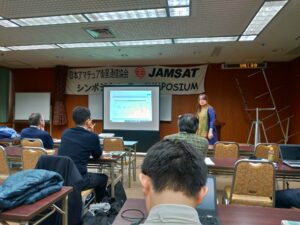
GNU Radio is a digital signal processing framework for software-defined radio. It’s the software that tells the hardware in your radio what to do. We need to be able to quickly and easily set up a software-defined radio to do whatever modulation and coding we want, and GNU Radio Companion can help us do this. GNU Radio Companion is a Graphical User Interface that allows us to drag and drop functions onto a canvas. We click block outputs to connect to block inputs. When we do this, it creates a directed graph that implements radio functions. The signals flow from beginning to end. Each block modifies the signal, as if it was part of a circuit. The flow graph looks something like a block diagram combined with a software flowchart. GNU Radio has software variables. It can adapt to signal conditions and user input.
The workshop was held after the last talk on Sunday. It was several hours of hands-on training. Participants brought their own computers, installed GNU Radio, and created useful radio flow graphs that worked with real hardware. Several experiments were done in order. Imamura-san kept everything organized through a set of projected slides that had clear instructions. Optimizations and customizations were made so that participants could see how they can use GNU Radio to achieve their goals. The hardware included RTL-SDRs and Plutos. Imamura-san also demonstrated a live video transmission from the podium.
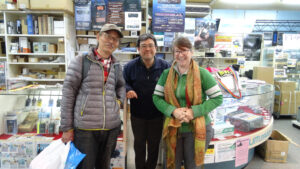
GNU Radio comes with a very large number blocks included. When you install GNU Radio, these blocks come for free! The first type of block is a source block. This brings the digital samples, from the radio hardware attached to the computer, into the GNU Radio flow graph. The second type of block is a sink block, which consumes signals. Sink blocks include things like saving a signal to disk, an audio output, oscilloscopes, spectrum analyzers, time sequences, or video. In between the sources and the sinks are all the radio functions that we need to make our radios work. Filters, amplifiers, decoders, demodulators, counters, constellations, costas loops, synchronizers, and more! You can make your own custom blocks or modify an existing block.

If you install GNU Radio using PYBOMBs, then you can add additional blocks from outside GNU Radio very easily. PYBOMBS works on Linux.
One of the most useful GNU Radio Recipes for our community is gr-satellites, by Dr. Daniel Estévez. There are a lot of satellites supported in this module. For an introduction, please see the source code repository here: https://github.com/daniestevez/gr-satellites.
The introduction also covers how to submit telemetry to the projects that have requested this.

Other great open source satellite communications projects include Dan Cajacob’s base station network, Alexandru Csete’s gqrx and gpredict programs, Libre Space Foundation’s SatNOGs (satellite network on the ground) with RTL-SDR and GNU Radio, and PE4WJ Es’Hail2 (QO-100) uplink, beacon tracker and LNB drift correction flowgraphs.
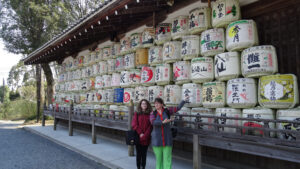
Phase 4 Ground is a broadband digital microwave system for both terrestrial and space use. It complies with both ITAR and EAR open source and public domain carve-outs, so it’s open to participation worldwide. All engineering is published as it’s created. All are welcome to participate.
Phase 4 Ground is best suited for GEO and HEO satellite missions. The uplink is frequency division multiple access. We use a 5GHz uplink. The regenerative repeater payload receives the uplink signals, digitizes them, multiplexes them, and processes them into DVB-S2 and DVB-S2X frames. The downlink is 10GHz. DVB-S2 is Digital Video Broadcasting Satellite 2nd edition. The X stands for extensions down in to Very Low SNR modulation and codings. Very Low SNR is of interest to hams, so we include the extension to the main standard DVB-S2.
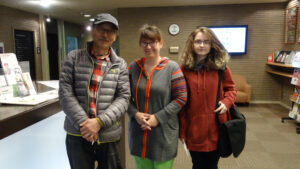
We use both pilots and short frame lengths in order to make the receiver implementation as easy as possible. Pilot tones are optional, and there are medium and long frames available in the standard.
There is a recommended order to receive DVB-S2/X frames. The first stage of the demodulator is symbol timing recovery. We have to figure out the best possible time to measure the received signal. We don?t know what the transmitter clock is doing! We will not be coordinated with it. We may even be off a bit in terms of the period of the clocks, or we might have jitter, or we might have drift. We have to analyze the received waveform and synchronize our receiver clock to the transmitter clock that is ?hidden? in the received signal. Then, once we are synchronized, we sample that symbol and report the results. Doing this gives us a reliable value for the received symbol. Now that we have a series of received symbols, we have to figure out the start of the frame. This is done in DVB-S2 (and many other protocols) by sending a fixed well-known pattern at the start of every frame. For DVB-S2, this is called a Physical Layer Start of Frame sequence. It?s 26 symbols long. This is what we look for. Once we see it, we know where the start of the frame is! Frame synchronization can be done in several ways. There are two different methods described in the implementation guidelines for DVB-S2/X. One is relatively simple, using shift registers. The other is bit more complex, using state machines. There are advantages to using the state machine method, but it?s more complicated and expensive. The shift registers is simple and cheap, but gives up a bit of performance. This is the constant balance in digital communications. Performance comes at a cost!
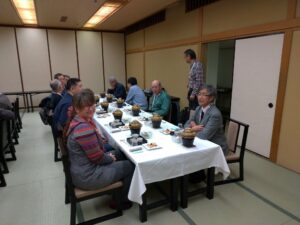
Right after frame synchronization, we correct for carrier frequency error. First we do a coarse correction. This can be done with a delay-and-multiply frequency error detector. Then we do a fine correction. This can be done with something like a feed-forward estimation algorithm. Coarse correction is in the MHz, and fine correction is the hundreds of kHz.
Next, we do phase recovery. This is to fix any residual frequency offset from the coarse and fine frequency offsets. Phase 4 Ground will support all the modulation and codings of DVB-S2/X, but we expect lower order modulations to be more heavily used. This means that a pilot-assisted maximum-likelihood (ML) feed-forward estimator will be the most useful. If you compute the average phase of each pilot field, then you can subtract this out and improve the signal. Higher-order modulations will need another feedback loop.
Automatic gain control is next. AGC can be done in many ways. One way to do it depends on the pilot symbols in DVB-S2/X standard. These symbols are sent at regular intervals to provide a known easy-to-receive signal. We use these known pilot symbols in order to determine the amplitude multiplication factor for the rest of the signal. Pilot symbols are optional in the DVB standard, but Phase 4 Ground requires them. When the pilot symbols are on, the AGC is listening. When the pilot symbols are off, the AGC turns off, and the information from the AGC is used.
After AGC, the constellation is decoded. DVB-S2 has a lot of them! There are many techniques to get the bits from the constellations. GNU Radio has a very versatile and powerful constellation block.
Instead of the usual MPEG transport stream (DVB-S2 is for satellite TV, so the content is usually broadcast television signals), we use the more flexible Generic Stream Encapsulation standard from DVB.org. This means we have less overhead and complexity, and can handle any digital traffic that the amateur operator wants to transmit. It?s just a digital pipe.
Phase 4 Ground uses GNU Radio extensively in research and development as well as for archiving and publishing our work. GNU Radio is not just a tool to figure things out, but is also a way to define a reference design for the radio.
Because Phase 4 Ground is not a bent pipe, the payload is more complex. This complexity needs to be fully tested on the ground before risking large digital circuits in space.
All the uplink channels are received with a polyphase filter bank. The current polyphase filter bank implementation in GNU Radio needs some updates in order to achieve the speeds and performance that we want. This is an active area of research and development. There have been three efforts over the past three years by various groups that have attempted to update and improve the existing working polyphase filter bank in GNU Radio.
Ron Economos and Paul Williamson successfully implemented GSE in GNU Radio and in Wireshark. This made it possible to do transport layer testing. Ron Economos is the lead author of the DVB blocks in GNU Radio. Improvements to GSE continue today. The current focus is improving internetworking functions so that large amounts of data can be more easily handled. We intend to use multicast IP as much as possible, and making sure GSE integrates well with multicast IP is important.
The error correction in DVB-S2/X is state of the art. There are not many other error correcting codes that are better than Low Density Parity Check + BCH. This is a concatenated digital code specified by the DVB standard for S2 and T2 transmissions. We have two open source implementations of LDPC decode for DVB-S2/X. The first one is for graphical processing units and was written by Charles Brain. It was demonstrated at 2017 AMSAT-NA Symposium and at several events following. The second open source implementation is in C by Ahmet Inan and can be found here: https://github.com/xdsopl/LDPC
This version has been incorporated into GNU Radio by Ron Economos. This can be found here: https://github.com/drmpeg/gr-dvbs2rx
The next step for LDPC is to implement and publish an open source version for FPGA.
GNU Radio is very important for our voice codec work, uplink modulation experiments, and trying out authentication and authorization schemes. GNU Radio allows us to use a wide variety of off the shelf hardware to achieve things that were not possible only a few short years ago. The GNU Radio community has been welcoming, helpful, supportive, friendly, and a source of continually amazing software-defined radio advancements.
GNU Radio has an annual conference. In 2018, we held a week-long “Block Party” for DVB-S2/X. We had fun, set up multiple demos, explained DVB-S2/X, made the case for open source LDPC, and made progress on DVB-S2 correlates and GSE. Phase 4 Ground made significant progress due to the generous support of the conference organizers and the community.
Learn more about the conference here: https://www.gnuradio.org/grcon/grcon19/
Registration for 2019 is open. The conference will be held September 16-20, 2019 in Huntsville, AL, USA. There is a poster session, proceedings, talks, workshops, contests, and social activities. The theme for 2019 is Space Communications! There are special gifts for space themed content. If you have a GNU Radio project that you want to share, consider making a presentation at or sending a poster to GNU Radio Conference 2019.
One of the proposals coming out of JAMSAT 2019 was localization of GNU Radio Companion for the Japanese language. Work has begun. The first step is to make sure that all Japanese characters can be displayed in GNU Radio Companion. This means going through the codebase and removing anything that prevents Japanese characters from being freely displayed. GNU Radio project leadership is very supportive of the project. We will do our best on this! We will need help reviewing and perfecting the language support in GNU Radio Companion.
The collaboration between Phase 4 Ground and JAMSAT has been absolutely stellar and we all look forward to continued enjoyment and success. Next generation payloads will be more complicated with multiplexing and advanced digital techniques. We all need to be able to work together, internationally. Open source and public domain is the best way. Phase 4 Ground and Open Research Institute are entirely dedicated to making this happen. We will be keeping the momentum and progress going. ORI is proud to be an affiliate member of Open Source Initiative https://opensource.org/
Join the Phase 4 Ground team! Our mailing list can be found at our website https://openresearch.institute/ Write Michelle Thompson w5nyv@arrl.net to join our Slack account. This is where daily engineering discussions take place.
More soon!
-W5NYV
Open Source Low Density Parity Check Decoder for DVB-S2, DVB-S2X, DVB-T2 Working in GNU Radio
An open source Low Density Parity Check decode from Phase 4 Ground is working for DVB-S2, DVB-S2X, and DVB-T2 in GNU Radio, thanks to the efforts of Ahmet Inan, Ron Economos, and Charles Brain.
This is a big step forward for open source satellite communications.
Video report here:
https://youtu.be/fOYVOgybFKY
Out of Tree (OOT) GNU Radio module by Dr. MPEG here:
https://github.com/drmpeg/gr-dvbldpc
Decoder by Ahmet here:
https://github.com/xdsopl/LDPC
DVB-S2/X Block Party at GNU Radio Conference
Hello everyone,
GNU Radio Conference is coming up in September. If you haven’t registered and want to go, please do at https://www.gnuradio.org/grcon-2018/
There’s a special event this year called Block Party.
It’s an effort to get DVB-S2 and DVB-S2X receivers in GNU Radio.
We will have our own room and tables and swag. We will have docents enthusiasm and test equipment. We’re looking for more! We’ll have documentation and refreshments.
We need blocks!
Most blocks needed for DVB-S2/X receive do, in some form, already exist. Some do not. Some just need additional modulation and codings added to them.
Receiver design is hard, but breaking it up into small blocks makes it tractable.
The DVB protocol documents are all open. There are implementation guidelines. See https://www.dvb.org/
There are several community members that are experts in this area. There is a team (Phase 4 Ground – find out more at https://phase4ground.github.io/) that needs DVB-S2/X to work in GNU Radio. There is a lot of interest from a variety of other groups including Libre Space, ARRL, AMSAT, and TAPR.
If you are able to contribute to this effort, I want to know about it! I am here to support it. I’d like nothing better than to complete the Block Party at GNU Radio Conference with working, tested, documented blocks for a DVB-S2/X receiver. This contribution makes our open source terrestrial and space radio designs for Phase 4 Ground possible, and also opens up a lot of other work.
The thing that is considered the hardest part is the LDPC FEC decode. We have an open source implementation that targets GPUs. We want to take this and get it into RFNoC. If you are working on this as well, we want to collaborate and support and combine and promote.
The GPU implementation (by Charles Brain G4GUO) of LDPC decode can be found at our repository folder here: https://github.com/phase4ground/DVB-receiver/tree/master/G4GUO-LDPC-on-GPU/DVB-S2XTxRx
Phase 4 Ground is devoted to an open source implementation of DVB-S2 and DVB-S2X for amateur radio terrestrial and space use. We are part of Open Research Institute. Learn more about this non-profit here: https://openresearch.institute/
